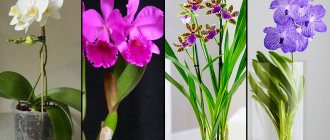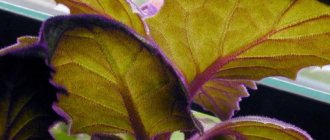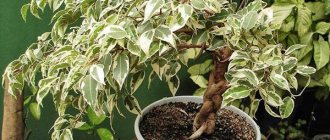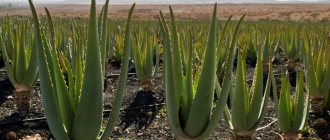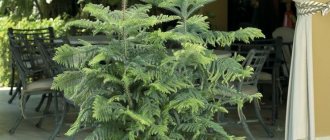Description of the flower
There are four groups of begonias:
- decorative deciduous - without an aboveground stem, with long leaves and ornate roots;
- bush - with branched, dense stems and many side shoots;
- flowering - distinguished by shiny, bright leaves and a long flowering period. They are considered the easiest to grow and care for;
- tuberous - have tall (up to 70-80 cm) translucent stems and tuberous rhizomes. Planting and caring for tuberous begonia from seeds is also quite simple.
Begonia propagation
Popular types of indoor begonias
- A group of ever-blooming begonias. Shrubs are no taller than half a meter. The leaves are wide, smooth, and veined. The stems are dense and fleshy. The flowers are small, collected in large inflorescences. Popular varieties are graceful begonia, Schmidt begonia, Colombian (lanciana). These varieties are best propagated as a whole leaf, with a petiole.
- Tuberous. A large group of plants with different leaves - pubescent and smooth, and thick fleshy stems. Famous representatives are pendulous begonia, Sutherland begonia, multifloral. Tuberous plants are usually propagated by dividing the tuber. But other methods of obtaining new plants are quite acceptable.
- Royal or rex begonia. A low, up to half a meter, herbaceous plant with a developed root system. The leaves are asymmetrical, jagged, with a sharp apex. On the front side they are velvety, complex in color. The reverse side is green with burgundy veins. The leaves are attached to the trunk on long petioles, making the bush look lush. The flowers are inconspicuous, small, pink. Propagation by leaves of royal begonia is possible; moreover, this is one of the best methods for this type of plant. Popular varieties are snail, griffin, dollar doun (with a black border along the edge of the leaf).
- Ampelous begonias. A group of plants with beautiful inflorescences and creeping shoots. Most often they are propagated by layering and cuttings.
- Begonia elatior, or winter. A very beautiful long-flowering bush with bright green smooth heart-shaped leaves. Begonia is propagated by leaves, since it does not have stems or shoots. Representatives: Annabel, Piccora.
Peculiarities
At home, begonia propagates by cuttings, seeds, and tubers. But it is leaf propagation that is used most often. This is due to a large number of positive characteristics.
- Losing one leaf will not in any way affect the health or appearance of the plant.
- None of the stages requires special skills, effort or time.
- This method can be considered the most productive: after all, about 10 shoots can be obtained from one leaf plate.
- For some varieties of begonias, this reproduction option is practically the only one.
- Unlike propagation by seeds, you will know exactly what the future plant will look like.
- Planting material acts as a source of nutrition. Thanks to the beneficial substances it contains, shoots will grow faster than from seeds.
In addition, the sheet itself can be used in different ways:
- wait for the roots to appear by placing it in water;
- land in the ground.
In the latter option, you can use the whole plate or divide it into parts.
How to grow a flower from a part of a plant?
Propagating begonias by leaf is a simple and effective way to grow new flowers . Recommended time: spring – summer.
This method has a number of positive aspects:
- makes it possible to get several young begonias at once;
- minimal damage is caused to the mother plant;
- Using this method, a new young plant can be grown at home in 1 to 3 months.
Attention : This propagation method is suitable for those types of begonia that are characterized by the presence of a pubescent lower part of the leaf and have a creeping stem.
When can begonia be propagated by leaf?
As a rule, this process does not have any time restrictions, however, it is generally accepted that plants rest in winter - for this reason, gardeners have an unspoken rule to replant and propagate plants from March to October inclusive, and not to disturb them the rest of the time.
Propagation by leaf cuttings
Fragments of a leaf
- Prepare everything you need: a sharp knife, a begonia leaf, a board or glass, substrate, drainage, pots, a plastic bag, activated carbon, “Kornevin”.
- Remove the leaf petiole.
- Cut the leaf placed on a board radially with a sharp knife from the middle to the edge into fragments in the form of triangles, each of which should have one or two veins, since all nutrients move along it. One sheet can produce 10 or more fragments.
- Treat the sections with crushed activated carbon mixed with Kornevin.
- Place a layer of drainage into the bottom of the container, then pour moistened substrate onto 2/3 of the pot.
- Having made a small groove in the ground, deepen the fragment into it with a cut downwards by 5 - 7 mm.
- Lightly crush the substrate with your hands, thus fixing the leaf segment.
- Cover the container with a plastic bag on top or place the pot in a special transparent plastic container that acts as a greenhouse.
Schefflera propagation: interesting methods and examples of planting
Some plant species do not have a stem, so the question arises of how to propagate begonia from leaves. You need to cut a healthy leaf from the plant and place it on a hard surface. It is worth taking a sharp blade or knife and cutting the leaf from the midrib to the edges of the triangles so that at least one vein passes through each of them.
Since it is quite difficult to root such a begonia, you can simply lay sections of the leaf on wet sand or try to stick the leaves with the cut of the vein into the soil.
Important! Caring for leaf cuttings is no different from others. It is necessary to cover the tank with the plant with a plastic bag, lid, jar or bottle so that the plant does not touch the walls. It is worth ventilating and humidifying the air in the container every day. You can stop keeping begonia in the greenhouse when new leaves appear.
Begonia propagation by leaf
leaf
First you need to prepare a large begonia leaf . It must look absolutely healthy, without damage or infection. Then you can leave it whole, or cut it into fragments. Each piece should have a portion of the midrib.
Advice! It is necessary to cut with a very sharp object. If you do not plan to separate the leaf blade, you can put the leaf in water until the roots appear. Place it in the place where the petiole was. Pre-dissolve an activated carbon tablet in water.
Cut on a sheet
Begonia can be propagated by making cuts on the leaf . To do this you need:
- Take a large begonia leaf, a knife, a pot, substrate, drainage, pebbles (pebbles), and plastic film.
- The bottom of the pot is filled with drainage, then with a moistened substrate.
- A large and healthy leaf (length 7 cm or more) is cut with a sharp knife across the veins in several places (the distance between cuts should be 2 - 3 cm).
- The cut leaf is placed face down on moist soil in a pot.
- Using small pebbles, the sheet is pressed to the substrate in places near the cuts.
- Cover the top with plastic wrap.
Rooting in water
The cuttings are immersed in a vessel with water at room temperature. You should not use hard or cold ones for these purposes. Place the vessel with the plant in a bright but not sunny place with a temperature of at least 18 °C.
A transparent container will allow you to observe the cut; after the first roots appear, the sprouts can be planted. You can also notice in time if the cut begins to rot. In this case, you need to remove the shoot from the water, cut off the damaged area, dry it and put it back into the water, preparing fresh water.
The cutting is ready for planting if the size of the roots reaches 2 cm.
Rooting in the substrate
The substrate can be wet peat, sand, or soil for begonias. The prepared cutting must be dipped into water, then into a product that will facilitate the formation of roots. It is recommended to prepare a small pot in advance, pour pebbles on top of the substrate as drainage, and deepen the cutting 2 cm deep.
After the work has been done, you need to tightly close the pot using a jar, glass or lid. In this case, no part of the plant should touch the walls or lid of the tank in which it is located.
Rooting begonia in the substrate
After some time, the inside of the container will be covered with perspiration, which indicates the formation of a microclimate suitable for reproduction. Every day it is worth opening the greenhouse slightly for a few minutes to ventilate the plant. Gradually it is worth increasing the time the flower spends in the fresh air. When new leaves appear, it is worth removing the lid completely, since the plant has become entrenched in the soil.
The soil
To root the leaf, a porous, moisture-absorbing soil with a neutral reaction and low humus content is required. To obtain soil with such characteristics, it is enough to mix peat and sand equally. Why use this mixture, and not ordinary soil:
- Sand prevents moisture from remaining on the soil surface and promotes its even distribution.
- Peat is more of a structural element instead of fertile soil, which itself contributes to the rotting of leaves falling on it.
- This soil breathes well, so rooting occurs well in it.
The soil for rooting should be at room temperature and moist . You don't need a large amount, 80-100 ml is enough. Before planting, it is necessary to disinfect the soil mixture with a saturated solution of potassium permanganate, or fry it in the oven. You can freeze the soil for a couple of days. More information about the soil for begonias and the correct planting conditions can be found here.
How to propagate begonia with leaf fragments, watch the video
Begonia propagation by seeds
The method is suitable for all natural species. For varieties it is used mainly when breeding Ever-blooming Begonia. Moreover, it is recommended to use it not only when owners sell planting material or want to arrange a large flower bed.
Begonia semperflorens will bloom especially abundantly only when grown from seeds. During vegetative propagation, the species and varieties derived from it produce fewer buds.
From the moment the shoots emerge until the first corollas bloom, the Ever-Blooming Begonia will take 4-5 months. Based on this, owners can adjust the timing.
Sowing seeds
Low, wide bowls are filled with soil for seedlings or peat mixed with sand, compacted, and watered so that the substrate is moist, but not wet. It is better to irrigate not with pure water, but with a solution of Fitosporin. This will protect the seedlings from many problems, including reducing the likelihood of blackleg disease.
Begonia seeds are very small and remain viable for up to 3 years.
In order not to thicken, when propagating, they are mixed with dry sand and sown on the surface of the soil as little as possible. They do not cover it with earth. Simply cover it with glass, transparent film or place it in a greenhouse.
Keep at a temperature of 22-26° C until the first shoots peck. Ventilate daily and check humidity. If necessary, water with warm water from a household spray bottle. The place should be moderately bright, without direct rays.
Seedling care
When the first loops of sprouts hatch, the seedling boxes are removed for a week in a cooler (about 16-18 ° C), but very bright place. This is necessary so that during reproduction the hypocotyledon does not stretch.
Irrigation is done carefully. It is better not to pour water on the leaves - there is a high probability of the sprouts rotting. You can take a pharmaceutical bulb, moisten the substrate along the edge of the container, or arrange bottom watering through a tray. They don't fertilize.
Picking
The operation is performed when at least 2-3 true leaves appear. It is inconvenient to work with small sprouts, but you cannot linger too long - due to the small seeds, the sowing during propagation usually turns out to be very dense, the begonia stretches out.
It is best to pick in plastic cups with a capacity of 50 or 100 ml, soil for seedlings with sand or perlite. There must be drainage holes in the bottom.
Picking process:
- Seedlings are removed from a common container with a special peg or a teaspoon.
- Separate one tail along with a lump of earth, if possible.
- Plant begonia in a plastic cup.
- Spill a solution of Fitosporin from a pharmaceutical bulb around the edge.
- Return it to the mini-greenhouse or cover it with a transparent bag, a jar, or a cut-off plastic bottle.
- After a new leaf appears, they are gradually accustomed to fresh air.
Growing seedlings
When breeding begonia from seeds, you need to create the following conditions:
- temperature about 18-20° C;
- not too sunny place - a northern window sill or lighting 8-10 hours a day is suitable;
- no drafts.
The first feeding is done approximately 1-1.5 months after picking, then every 2-3 weeks. As soon as the flower grows a little, pinch the crown so that the bush branches more strongly.
Choosing a vessel for rooting
The plant has small roots, so you should choose a low, small pot for it. In this case, the substrate will quickly get rid of excess moisture, so it is less likely to die. In this case, during rooting, the plant will not remain in the container for long; when roots appear, you will need to choose an individual pot.
Note! Lighting for cuttings is necessary to the same extent as for adult plants, so the rooting period should be carried out in a well-lit place. You can use a regular plastic cup as a vessel.
The pot that will be used after transplantation should not be more than 800 ml in volume, and it is worth making a hole in the bottom so that excess water can drain through it. If the plant becomes cramped in the pot, you will have to choose a larger option. After replanting, it is recommended to keep the plant for a couple of days in a darker place than usual.
Plant propagation by leaf
Begonia propagates quite easily not only by stem cuttings, but also by leaves. More often this method is used for decorative leaf and “climbing” species. For many varieties of crops, leaf propagation is the main method. This method is advantageous in that it is possible to obtain several plants from just one leaf.
To reproduce, you need to take a strong and healthy leaf from the plant. It can be rooted alone or cut into pieces to produce several begonias. It is cut lengthwise so that each leaf segment has at least one vein. It should look like cones. Then, for rooting, the cut leaf fragments are placed in the narrow part into the prepared soil. You can do this in two ways:
- placing them vertically in the ground, deepening the narrow part into the moistened soil by about 1 cm;
- placing it horizontally in a container with a damp substrate on its surface, lightly sprinkling the cut parts of the leaves along the edges with soil so that they are slightly pressed to the ground.
The containers with planting material are covered with glass or a plastic bag on top so that the air inside remains moist, and they are placed in a warm and well-lit place. It is necessary to keep the soil moist by spraying it with a spray bottle, and regularly ventilate the greenhouse. Germination will take about 1-2 months, after which the cover is removed. Young children then, when they grow a little, are planted in separate pots.
Which plant propagation method to choose depends on the variety of begonia, the availability of planting material and the preferences of the grower. For some species of this crop, other propagation methods are used - tubers and dividing the bush.
Seeds
Seeds must be purchased from trusted producers.
The seed method of propagating begonia is labor-intensive, but allows you to obtain a large number of young seedlings at the same time. This method is used for flowering plants, since the resulting bushes are characterized by high immunity and abundant flowering throughout the season. This is explained by the fact that during the growth process the seedlings fully adapt to existing conditions.
Step-by-step guide to seed propagation:
- 3 days before planting, the soil must be disinfected with a bright pink solution of potassium permanganate or Previkur (10 ml per 7 liters of water), which will reduce the risk of developing root rot during the growth of seedlings;
- put a 1 cm layer of drainage on the bottom of the container;
- fill the containers with prepared soil and water;
- wait until the moisture is completely absorbed;
- level and compact the soil surface;
- place the seeds at a distance of 2 cm from each other, pressing them slightly to the ground;
- cover containers with glass or film;
- place for germination in a bright place at a temperature of 23–25 degrees;
- Periodically ventilate containers and remove accumulated condensation.
Sprouts will appear within 10–12 days.
When the seedlings appear promptly, the temperature must be lowered to 20 degrees so that the seedlings do not stretch. In the future, it is necessary to control soil moisture, avoiding overwatering or drying out of the roots. Moisturizing the soil when the top layer dries out must be done from a spray bottle, not forgetting to remove condensation on the lid daily.
When 2 true leaves appear, it is necessary to adapt the seedlings to new conditions. To do this, on the first day you should open them for 30–40 minutes, and every day increase this period by 30 minutes. A week after the start of the procedure, the cover must be completely removed. After another 2 weeks, you can transplant the plants into separate containers.
The more often you replant begonias as the seedlings grow, the faster they will grow and develop.
Aftercare
To grow a beautiful begonia, you must follow certain rules.
- The young plant should be kept away from sunlight and drafts. The same applies to the adaptation period after transplantation.
- When the plant is strong enough, it can be moved to the sun and slowly hardened off. Begonias are used to decorate balconies, and some species can be safely planted in flower beds.
- Since the historical homeland of begonias is tropical forests, humidity is important for them. During the hot season, the pots can be placed on a common tray with pebbles and water. You can also spray the air near the plant and be sure to install a humidifier in the room.
- In summer, watering should be quite frequent: 2-3 times a week. The rest of the time, the soil is moistened as it dries.
- During the period of active growth of begonia, fertilizers are needed. They need to be paid at least once a month.
- An adult plant is practically not replanted. An exception may be diseases: rot, powdery mildew, bacterial diseases that appear as spots on the leaves. Plants are often attacked by pests. To identify diseases as early as possible, regular examinations are needed.
Watering
Watering young plants must be done in a timely manner and extremely carefully . Otherwise you can destroy them. The water should be no lower than room temperature or 2-3 degrees higher. It should be soft and settled. You can water young begonias using a syringe or spoon.
You can't get on young shoots. An adult plant that has already grown a root system is best watered through a tray. The soil should always be slightly moist; excess water threatens the development of various diseases.
We follow other care measures:
- A couple of weeks after planting in the pot, you can begin regularly applying mineral fertilizers. Complexes for flowering flora are suitable. This should be done 2-3 times a month.
- We provide begonias with a period of rest during the winter months.
- Every year we transplant the begonia into a larger pot and replace the soil.
How to care for young begonia
- When picking and planting for permanent residence, do not deepen the growing point (tender root collar) of the seedling.
- After any picking and replanting, shade the plant for a couple of days, and only when you see that it has taken root in the new pot, expose the begonia to the light.
- Drainage is required. Depending on the size of the plant, its layer should range between 0.5 and 2 cm.
- Take a wide, but low pot, since the roots of the plant do not lie deep.
- Basic principles of caring for young flowers: moderate watering, a sufficient amount of light (but without direct rays), temperature about 20 degrees, fertilizing from spring to autumn (depending on the variety, take mineral fertilizer either for decorative flowering or for decorative leaves). It is not necessary to spray the flowerpot; you can simply keep it on a tray with wet expanded clay.
Well, when the begonias grow and begin to delight you with bright flowers (or no less elegant decorative leaves), you will need to care for the plant according to the following principle:
Transplantation into the ground
Young begonias, propagated by cuttings in water, very quickly produce roots about two centimeters long. They are immediately transplanted into special soil for begonias. You can prepare the mixture yourself from leaf (or turf) soil, peat, vegetable compost, humus and coarse river sand, in equal proportions.
After replanting, do not compact the soil around the stem of a young plant, especially at the root collar, so as not to damage the delicate roots. The planted cuttings can simply be watered.
Additional recommendations
It is better to plant rooted begonia cuttings in a wide but shallow pot. The roots of the flower are on the surface. Be sure to place a layer of drainage (pieces of red brick or large expanded clay) on the bottom of the container.
A young sprout of tuberous begonia should be planted so that the tubers are at a distance of 2 cm from the edge of the pot.
The growing point of the cutting (or root collar) should be at the level of the soil surface. There is no need to deepen it.
Immediately after transplanting, you need to place the pot in a shaded place. You can move it to a lighted area of the house after 3 days.
Advice from experienced gardeners on further cultivation
After begonias have been propagated, it is necessary to follow some rules.
- When planting cuttings in permanent pots, it is necessary to deepen them. Because young seedlings have weak roots;
- When watering, drops of water should not fall on the leaves. Plants cannot tolerate this;
- They begin to feed begonias 2-3 weeks after they are planted.
Begonias can reproduce in a number of ways. The gardener should choose which method he likes best and soon the begonia will bloom on his window!
Home care
The greenhouse is usually placed in a warm (+20C - +24C) and bright place, but a place without direct sunlight. If propagation is carried out in winter, then the seedlings need to be provided with additional lighting. For young plants, temperature changes and drafts are not allowed . You cannot remove the greenhouse until new formed leaves appear!
With the appearance of the first young leaves, the plant needs to begin to accustom itself to indoor air. To do this, first for 3-5 minutes, then for 10 minutes daily, remove the bag or slightly open the lid of the greenhouse.
Over time, the duration of these “airings” needs to be increased. After the leaf segments have formed roots, they can be removed from the greenhouse and moved to a permanent location.
Propagation of plants by tubers
Let's look at how to propagate tuberous begonia starting in winter. Preservation of begonia tubers should be done in the fall; wintering takes place in a warm place without temperature changes. If stored properly, you will find young buds and even shoots in the spring. First you need to carefully examine the tuber and mentally divide it into parts so that the buds and shoots are preserved, 2-3 of each. After cutting the tuber, the cut site must be treated to prevent rotting. Ash, charcoal, and brilliant green are suitable for processing. After the cutting lines have dried, the tubers can be planted in open ground.
Possible problems in cultivation and diseases
During periods of stress, begonias may drop buds and leaves. This happens after a hard winter or the first transplant. When the plant recovers, it will gain strength again.
Pale leaves occur when the soil is depleted. The plant can be revived by replanting it in fresh enriched soil, and also help with fertilizing.
Drooping leaves indicate an excess of water, and dried tips, on the contrary, indicate a lack of water. The flower dies from improper watering.
If only the lower leaves of a plant are falling off, it may be a natural process of wilting, especially if the leaves are well developed. If this happens throughout the entire plant, you need to check whether your indoor begonia is being properly cared for.
The flower can be affected by diseases and pest invasions. Among the most common are aphids and spider mites - you can get rid of them using garden chemicals. But nematode worms are a more complicated problem. They leave characteristic ornate marks on the leaves, and it is almost impossible to get rid of them. The plant will be difficult to save.

